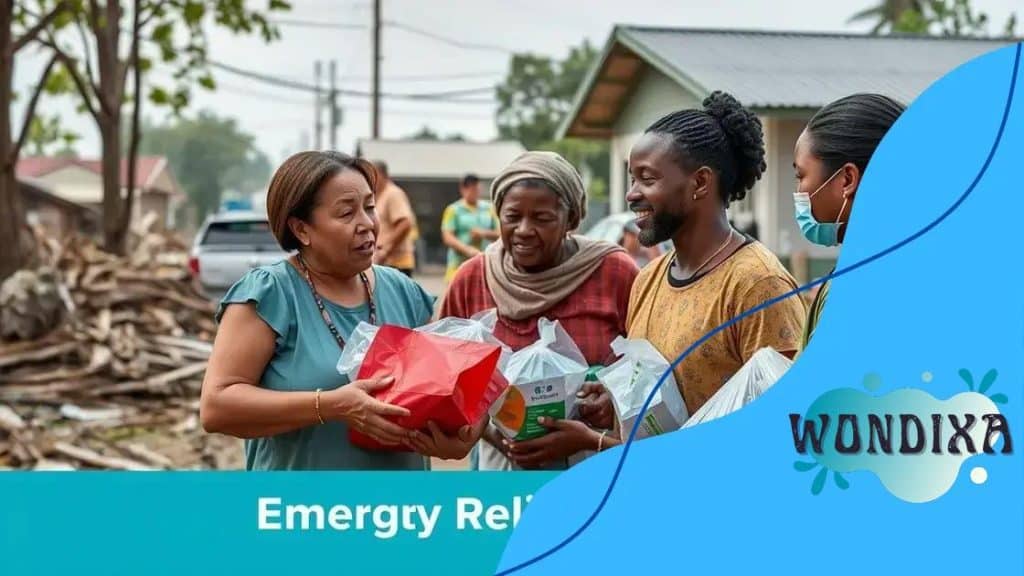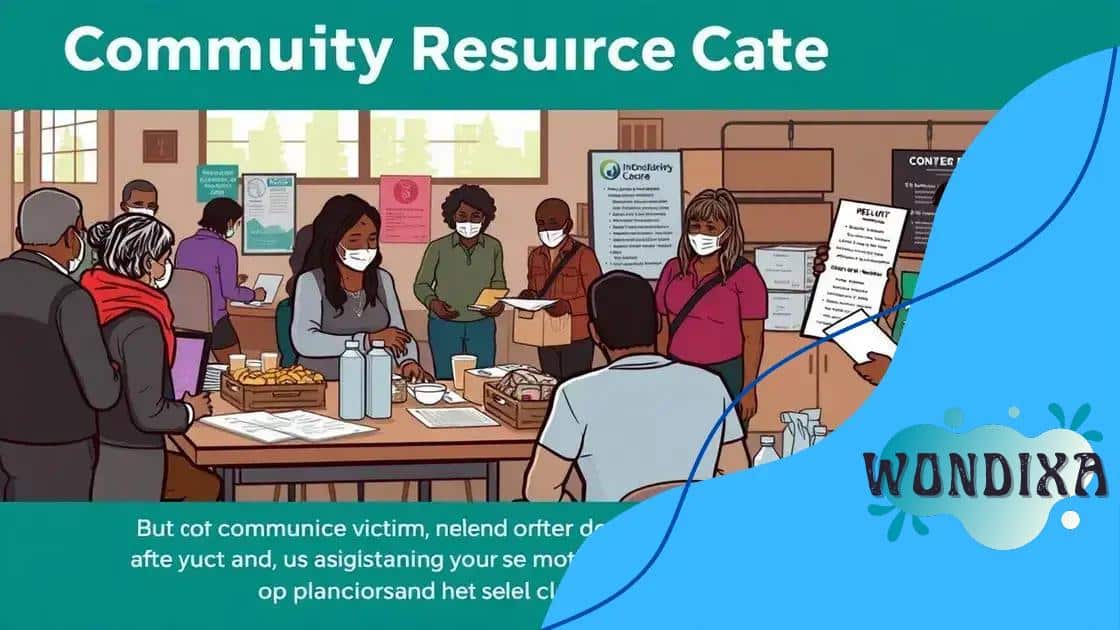Emergency relief funds for natural disasters: what you need to know

Emergency relief funds for natural disasters provide crucial financial assistance, housing support, and access to food and medical care, helping communities recover and rebuild after catastrophic events.
Emergency relief funds for natural disasters play a vital role in supporting affected communities. Have you ever wondered how these funds really work or how you can access help when disaster strikes? Let’s dive in.
Understanding emergency relief funds
Understanding emergency relief funds is crucial for anyone affected by a natural disaster. These funds provide necessary support when communities face unexpected challenges, offering help when it’s needed the most.
Emergency relief funds generally aim to assist individuals and families in recovering from disasters. They can cover basic needs like housing, food, and medical expenses. Having access to these funds can significantly ease the burden during tough times.
How do emergency relief funds work?
These funds typically come from government programs, charitable organizations, and local agencies. When a disaster is declared, different agencies activate resources to distribute these funds effectively.
Types of assistance available
- Temporary housing solutions
- Food assistance programs
- Medical care support
- Employment recovery resources
In addition to emergency services, financial aid can also support long-term recovery plans. These funds can facilitate the rebuilding of homes and businesses, ensuring that the affected communities can regain stability.
Challenges in accessing relief funds
While the availability of funding is crucial, the process might not always be straightforward. Individuals often face complicated application procedures which can delay support. Understanding the requirements beforehand can help ease this process.
Awareness of various programs and their eligibility criteria is important. Community workshops and informational sessions can provide valuable insights, making it easier for families to navigate the resources available to them.
The process of applying for disaster funds
The process of applying for disaster funds can be daunting, but understanding the steps involved can make it easier. Once a disaster is declared, individuals can seek help by reaching out to various organizations and agencies.
To start, gather important documents. This includes identification, proof of income, and details regarding the damages incurred. Having everything ready can speed up the application process.
Steps to apply for disaster funds
First, find the right agency to apply to. This might be a government office or a non-profit organization. Next, fill out the application form thoroughly.
- Ensure all required documentation is attached.
- Submit the application before the deadline.
- Follow up with the agency to check the status.
After submitting, it’s common to wait for a response, but staying proactive helps. Some agencies might require further information or clarification. Being prepared for additional steps can help maintain the momentum of the application.
Tips for a smooth application
Utilizing online resources can provide guidance on what to expect. Many organizations offer checklists to ensure nothing is missed. Additionally, consider reaching out to local community centers or support groups for assistance in navigating this process.
Remember, applying for disaster funds isn’t just about filling out forms; it’s about seeking the help you need during a tough time. Understanding the application process can help clarify your next steps and put you on a path to recovery.
Types of assistance available

After a natural disaster, understanding the various types of assistance available can help families and individuals navigate their recovery. Different organizations provide support designed to meet immediate needs and facilitate long-term rebuilding.
It’s essential to know what types of aid you can access. This assistance typically includes financial help, housing solutions, and access to food and medical care. Understanding these options makes it easier to apply for the necessary support.
Financial assistance
Financial aid is often the first type of assistance requested. It can come from government programs or nonprofit organizations and generally covers:
- Emergency cash grants for basic needs
- Repair and rebuilding assistance for homes
- Funds for temporary housing accommodations
Having these funds can relieve some of the immediate financial burdens that arise following a disaster.
Housing solutions
Many families may face displacement due to damage or destruction of their homes. Housing assistance can include:
- Temporary shelters set up by agencies
- Subsidized rentals in nearby areas
- Repair programs for damaged homes
Accessing housing support quickly can help families stabilize their living situations during recovery.
Food and medical assistance
In addition to financial and housing support, food and medical assistance are crucial in the aftermath of a disaster. This can involve:
- Food banks providing essential groceries
- Emergency meal delivery services
- Access to medical care and mental health services
Recognizing these types of assistance available can significantly impact the recovery process, bringing communities back to stability.
How communities have benefited from relief funds
Understanding how communities have benefited from relief funds highlights the importance of these resources in times of crisis. When natural disasters strike, these funds play a crucial role in recovery efforts.
Relief funds help communities rebuild and restore essential services. For example, funds can be used to repair schools, restore public utilities, and improve local infrastructure. This not only aids recovery but also strengthens community resilience for the future.
Case studies of successful recovery
Many communities have demonstrated the positive impacts of receiving relief funds. In one case, funding helped rebuild a community center that had been destroyed. This center became a vital hub for distributing food and resources, allowing families to recover more quickly.
Enhancing community cohesion
Relief funds also foster community engagement and support. Many relief efforts involve local volunteers working together. This collaboration helps strengthen community ties and builds a sense of unity. Volunteers often report feeling a deeper connection to their neighbors as they work toward common recovery goals.
Long-term benefits
By utilizing relief funds, communities can not only address immediate needs but also plan for future challenges. Investing in sustainable practices and infrastructure creates a stronger foundation for long-term recovery. This proactive approach can mitigate the impacts of future disasters, making communities more resilient.
Ultimately, the benefits of relief funds extend beyond immediate assistance. They support recovery, foster community spirit, and lead to lasting improvements that help prepare for future challenges.
Challenges in accessing emergency funds
Accessing emergency funds can be a critical lifeline after a disaster, but there are many challenges individuals may face in securing this aid. Understanding these challenges can help effectively navigate the system and improve the chances of receiving support.
One major challenge is the complicated application process. Many relief programs have specific eligibility requirements and extensive forms that need to be filled out. If applicants are unfamiliar with these processes, they may feel overwhelmed and unsure of how to proceed.
Common barriers to access
Another issue is the delay in processing applications. After a disaster, agencies could be inundated with requests for assistance. This might lead to long wait times for applicants. During this period, people may struggle to meet essential needs while waiting for much-needed support.
Understanding eligibility criteria
Eligibility criteria can also pose a challenge. Many people may find that they do not qualify for the available funds based on their income level, existing resources, or other factors. This can cause feelings of frustration and helplessness.
Importance of community support
Community organizations and local support networks can help bridge these gaps. They provide assistance with understanding the application process and preparing necessary documents. Many community groups offer workshops to educate potential applicants about what to expect and how to successfully navigate the hurdles they may face.
Having access to this type of support can make a significant difference in overcoming barriers to emergency funds. Efforts to simplify application procedures and increase accessibility can ensure that those in need receive prompt help.
FAQ – Questions about accessing emergency relief funds
What are the common challenges in accessing emergency funds?
Common challenges include complex application processes, delays in processing, and strict eligibility criteria that can prevent some people from receiving aid.
How can community organizations help with the application process?
Community organizations often provide resources, workshops, and personal assistance to help applicants understand the process and complete necessary documentation.
What types of assistance can be obtained through emergency funds?
Emergency funds can provide financial aid, temporary housing, access to food, and medical support to individuals and communities affected by disasters.
Why is it important to simplify the application process for relief funds?
Simplifying the application process can improve access to aid, ensuring that more individuals receive the support they need promptly during critical recovery times.





